How to recognize a good bottle of French wine.
The Bordeaux wine region is a special place and I felt lucky to spend a few days there experiencing the 2019 wine harvest. Bordeaux is THE place to understand our love affair with wine. Walking through the chateaus and vineyards of the Bordeaux region helped me learn how to recognize a good bottle of French wine when I see it. In the past, I’d toured other wine regions in France – the Loire Valley, the Rhone wine region including the beloved Chateauneuf de Pape, but Bordeaux is home to the famous French Chateaus. Chateau Lafitte, Chateau Mouton-Rothschild, Chateau Latour, Chateau Margeaux and on and on. This felt like the place where wine had been invented, but alas, it all started in the country of Georgia in 6000 B.C. But the French have had a starring role on wine’s world stage for a very long time.
So what’s different between California wine and French wine?
Since I live in Southern California, I have learned quite a bit about California wines. I’ve been fortunate to travel and to taste amazing wines throughout all of California. So what’s different between the California wines and French wines? The French would scoff at any comparison, but if you’ve visited wineries in California, you will find the French experience at least in the Bordeaux region to be much different. James Dinner of Le Cellier de Saint Emilion, a Canadian and self professed wine geek has been making his way around the world working in the wine business including a stint at Napa Valley’s infamous French Laundry restaurant. Ask him a question or two.
Look for Terroir (A.O.C.) on the bottle.
First of all, you must understand the word “terroir” from the word “terre”, which means land. This means that the land in a certain geographic region is unique in soil, topography and climate to other geographic regions and it may dictate the best variety of grapes to grow in that region. This is also called A.O.C., which you will see written on the bottle. Appellation d’origine contrôlée, which means “controlled designation of origin” in French. OR A.O.P. Appellation d’Origine Protegee. This also applies to other products from the land, such as olive oil. In California, the words American Viticultural Area (AVA) are used instead of A.O.C. and is used on only the top tier wines.
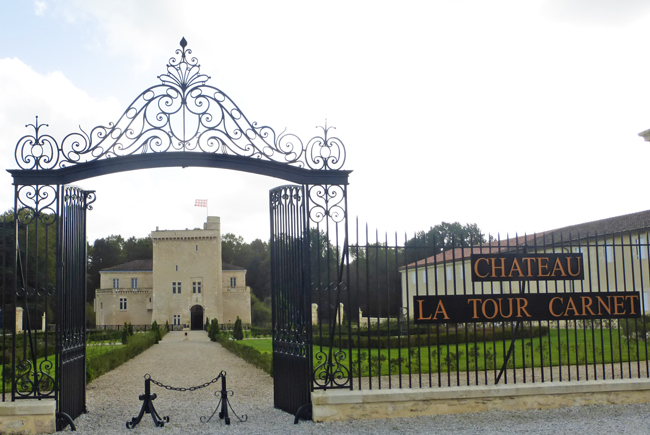
You can stay at the luxe Chateau La Tour Carnet for 250 euros/night.
Bordeaux is home to 8000 Chateaus.
A winery or a property that produces wine in France is called a chateau. In the Bordeaux region alone, there are about 8000 chateaus. A chateau can be a fancy looking building we think of as a chateau like the Chateau La Tour Carnet above or it can be someone’s home or garage, where they make the wine from their property in the region. The reality is that there are about 350 chateaus that you could visit in the Bordeaux region.
Only six grape varieties are grown in St. Emilion and Medoc A.O.C.s.
In the St. Emilion and Medoc regions of Bordeaux, there are only six grape varieties planted. Cabernet Franc, Cabernet Sauvignon, Merlot, Petit Verdot, Malbec and Carmenere. Most of the wine is blended from the Cabernet Franc, Cabernet Sauvignon and Merlot, with possibly a small amount of the other three grapes added for the “winemaker’s recipe”. In California, you will find that the wineries are not limited to what varietals they can grow on the property they either own or contract with. Often you will see certain areas choose a varietal that is good for that “terroir” such as Cabernet Sauvignon in Napa Valley and Pinot Noir in the Santa Rita Hills of Santa Ynez Valley near Buellton and Solvang.
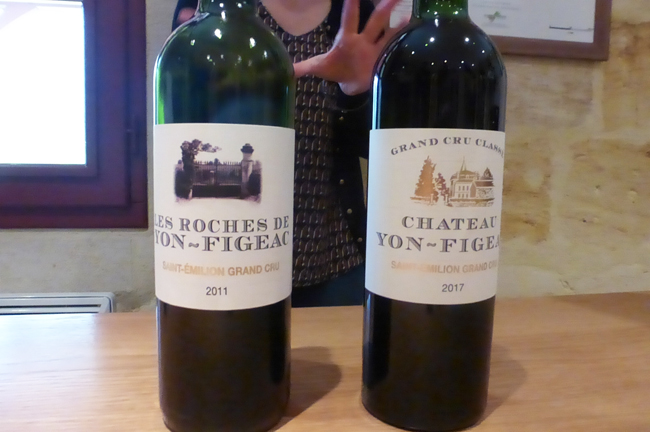
We tasted the Grand Cru classe wine at Chateau Yon-Figeac along with their secondary wine, Les Roches de Yon-Figeac.
When you visit a winery in California, you will often taste a lot of different varietals or types of wine that may be farmed from different regions than where the winery is physically located. In France, they produce one varietal and it is named for the region or appellation or terroir where not only the grapes are grown, but where the Chateau (the name for a winery) is located. The best known example is that only wine from the Champagne region in France is called Champagne. The chateaus in the Champagne region will only make Champagne. Everywhere else, including California, what we may think of as champagne is called sparkling wine.
I visited the St. Emilion, Pomerol and Medoc regions near Bordeaux and each area made a unique wine to that area. They offer different wines based on the quality of the grapes, rather than different grapes. Their top tier level would use the Chateau name on the label and the lower tier might have a slightly different name.
The Pomerol A.O.C. is home to the famous Chateau Petrus, which is among the most sought after French wine. We tasted wines from Chateau du Tailhas in Pomerol which shares the same A.O.C. or soil, topography and climate. While more affordable, their wines bask in the glow the Chateau Petrus receives. If you find a bottle of wine from Pomerol at your wine store, you might want to purchase it knowing it shares the same A.O.C. as the famous Chateau Petrus.
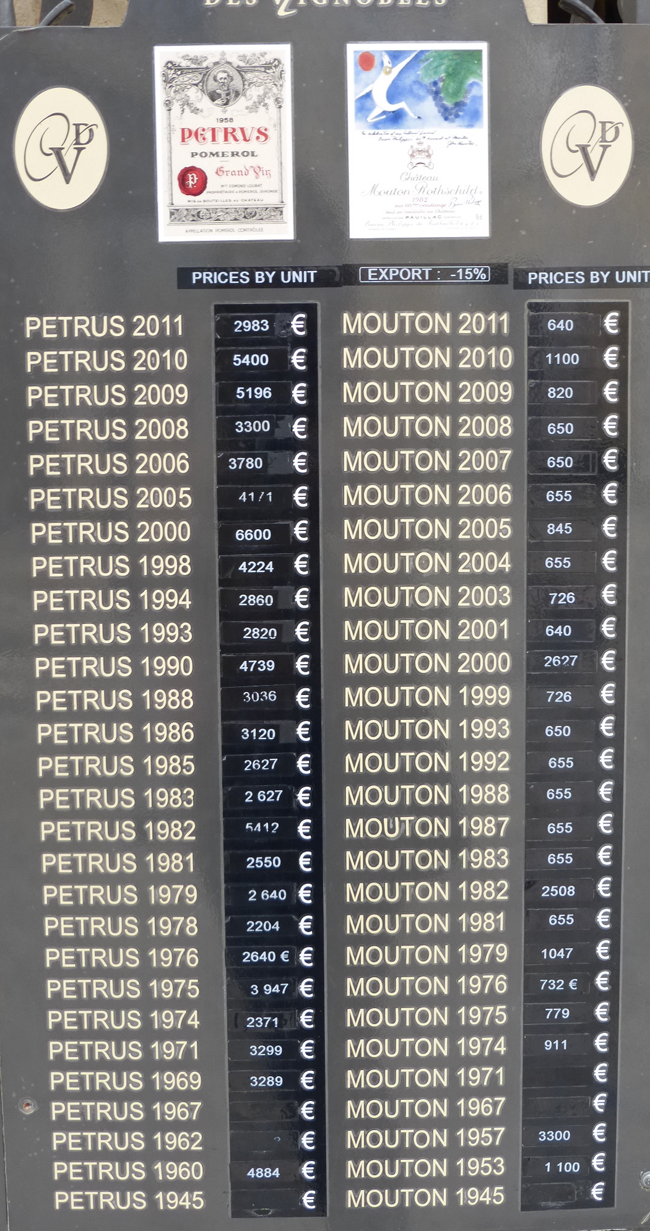
A wine store in St. Emilion displays the going price for a bottle of the two most sought after Premier Grand Crus – Chateau Petrus and Chateau Mouton-Rothschild.
What to look for on a bottle of French wine.
Quality is noted by words on the label. Grand Cru means that the chateau has earned a certain level of distinction. Not every Chateau has the distinction of Grand Cru. Cru Bourgeois is a marketing term meaning not a Grand Cru, but notable.

Chateau Dauzac is a Grand Cru Classe in the Margaux A.O.C. of the Medoc region. Aurore de Dauzac on the right is the secondary wine from Chateau Dauzac.
The Medoc region is well known for its Cabernet Sauvignon wines. Beginning in 1855, the Medoc region established only five chateaus that have earned the best or Premier Grand Cru Classé: Margaux, Lafitte, Latour, Haut-Brion and in 1973 Chateau Mouton-Rothschild. These chateaux are considered the creme de le creme in the wine industry worldwide. Although, a Napa Valley Stags Leap Cabernet Sauvignon beat out the Bordeaux in some blind tastings in 1973, which catapulted California wine onto the world stage. Searching for a bottle of Premier Grand Crus from these five chateaux will set you back about $600 or more. There are also other Chateaux in the Deuxiémes (2nd) Crus, Troisiémes (3rd) Crus, Quatriémes (4th) Crus, and Cinquiémes (5th) Crus. See the Chateaux here. Then plain Grand Cru follows these luxe chateau brands, but is still something special.
Plan ahead when you visit Chateaus in France.
Visiting the chateaus in France to taste wine is not as simple as it is in California. Here, you can check the hours of the winery and show up. Most of the chateaux in France require reservations and charge for tasting. You can arrange them through the Tourism office or the Maison du Vin. I can recommend going with a tour company from the center of Bordeaux. They will meet you at the central tourist office and transport you by van or bus. I went with Ophorus Excursions arranged by CocoTrav Travel for a full day St. Emilion Trip to three chateaux.
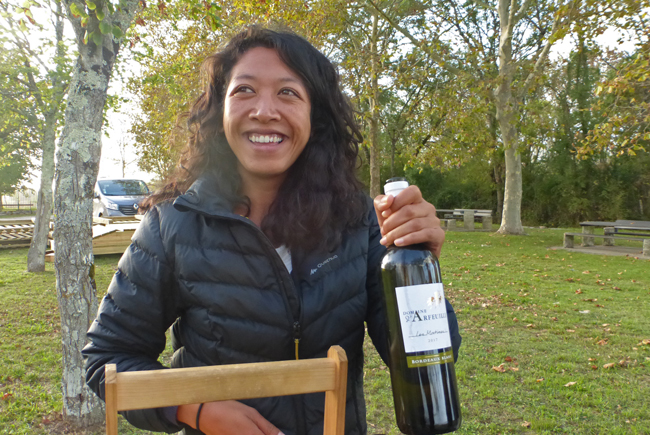
Debbie, our guide of the Medoc wine region surprised us with a bottle of Bordeaux to enjoy the sunset over the Garonne river.
The second day, I did a half day tour to the Medoc region with Bordovino arranged with the Bordeaux Tourism Office where we visited two chateaux. On each tour, we were given a tour of the Chateau – it’s building, the cave where the wine is stored, a walk near or through the vineyard and a tasting at the conclusion.
The harvest during late September – mid October when I visited Bordeaux was a busy, but perfect time to experience the full circle of wine production. Witnessing the grapes still on the vine being picked and then smelling the grape juice begin fermentation in the stainless steel tanks, while it was being aerated and crushed of its stems, seeds and skins. C’est tres bon! We even tasted the grapes at their prime before they were picked! The juice was sweet, while the skins and seeds bitter and acidic, giving the wine the perfect balance.
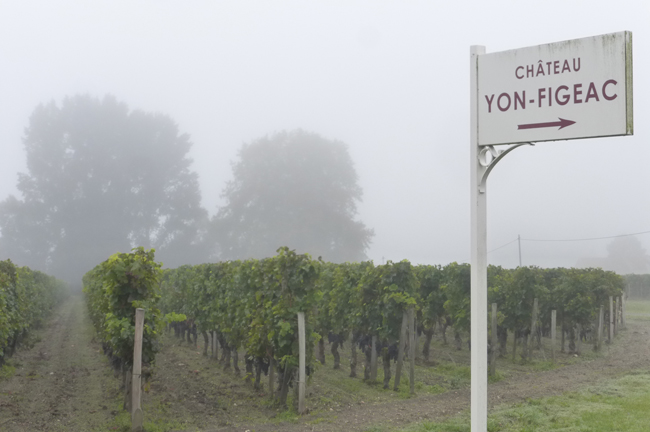
The grapes like the foggy autumn mornings combined with sunny warm afternoons here in the St. Emilion A.O.C.
Dry Farming Makes a Big Difference in Concentrated Flavor.
One of the big differences from California wine making that I discovered about the Bordeaux region is that the chateaux practice dry farming. The chateaux cannot irrigate their vines or they risk losing their A.O.C. They experience about 120 days of rain per year. This intensifies the flavor in the grapes and the weather can make or break a vintage.
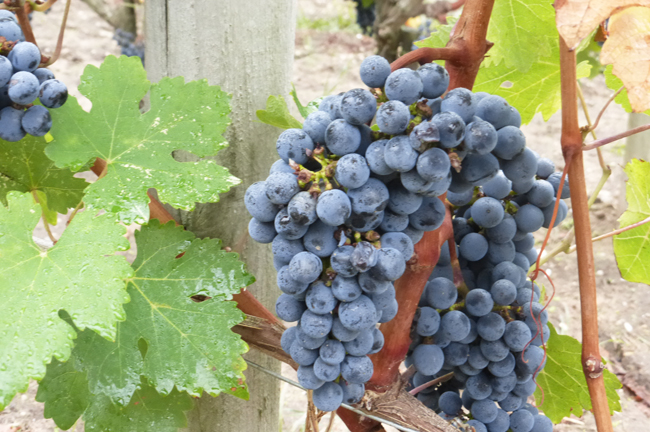
The ripe grape had sweet juice, acidic skins and bitter seeds providing balance as the wine is being fermented.
What vintages to look for in French wine.
The years 2000, 2005, 2009, 2015 are considered good wine years. The heat in France this year helped to intensify the juice in the grapes followed by a cool fall while harvesting and they are expecting 2019 to be an excellent year. While a number of high end vineyards in California are also practicing dry farming, most of our vineyards would not exist without the help of irrigation. California is famously a dry desert region, particularly in Southern California where we often get little or no rain from May – October. Dry farming is going to naturally increase the price of the wine, since the production will be far less than when a vineyard is irrigated. However, the concentrated flavor is what the wine maker is after for their top tier wines.
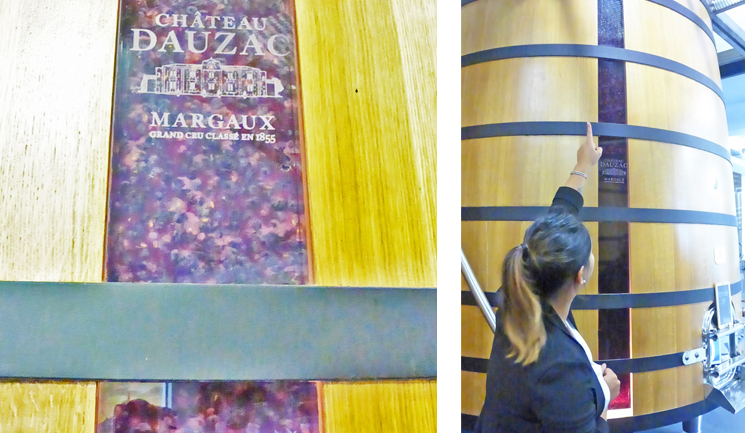
This oak barrel at Chateau Dauzac has a clear insert where you can see the juice, the skins and seeds of the grapes sloshing around.
The winemaking process is where the Chateau puts its unique stamp on the wine.
The stainless steel tanks and large oak barrels at Chateau Dauzac were humming on my visit to the five different chateaux with recent grapes being added from the harvest.
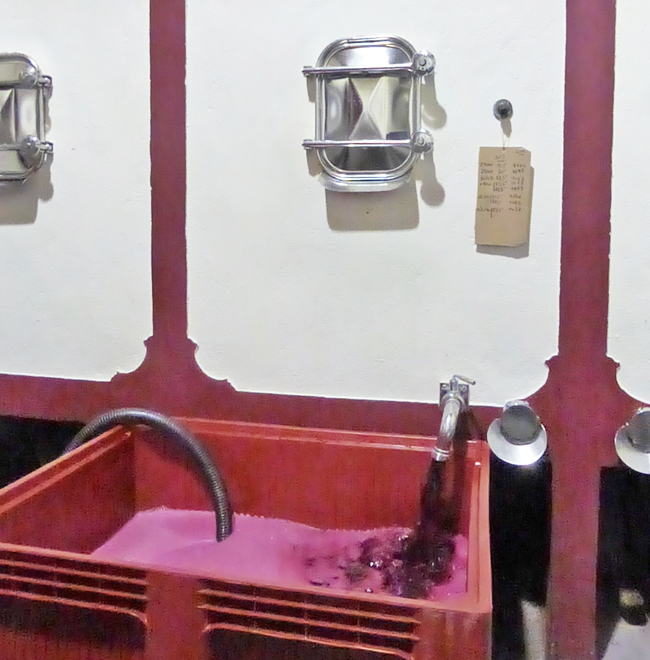
The Merlot grape juice at Chateau Tailhas in Pomerol that were picked the week before is aerated and mixed.
The workers were moving hoses around from tank to tank to aerate and mix the juice to obtain contact with the skins and seeds. At Chateau Tailhas in Pomerol the Merlot wine is emptied into a bin and then siphoned back to the top of the tank. When the grapes are first crushed, the juice is clear. As the wine ferments over 8-12 days, the contact with the skins is how it develops the red color.
Once the fermentation is complete, the skins and seeds are removed and the wine is placed into French oak barrels for two years.
The barrels are traditionally stored underground in caves. Today, some of the chateaux have large production needs and so the above ground caves are temperature controlled. When we visited Chateau Guadet in the heart of St. Emilion’s little village, we were led down some tight stairs to a cave which held bottles of wine from vintages going back to the early 1900s, It was eerie and wonderful to experience the history of this chateau.
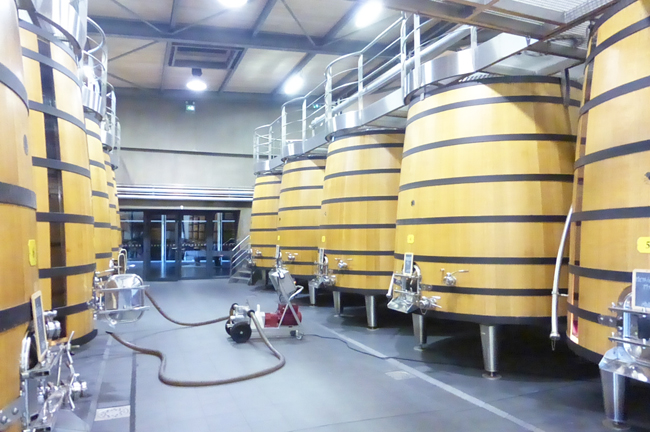
The oak tanks at Chateau Dauzac are used both for the fresh grapes and the final blending of the wine.
After spending two years in the small barrels, the wine eventually ends back in the large barrels or tanks to be blended before it is bottled. This is when the magic begins. The winemaker puts his or her stamp on the wine that goes into the bottle. In Medoc, more Cabernet Sauvignon is used in the winemaker’s recipe. In St. Emilion, Merlot is predominant in the blend, but the winemaker chooses from only the six grapes shown above.
Put a trip to Bordeaux during the harvest on your bucket list.
Spending three weeks in France taught me how my focus on food and wine is so…well…French. Nothing spoke to me more than enjoying a few days in Bordeaux after already absorbing the French countryside and culture. The focus on spectacular ingredients, the focus on simple cooking techniques, the leisurely lunch hour and a half and the way in which the French REALLY enjoy their food and wine was simply a pleasure to experience.
Visit the Bordeaux markets on Saturday morning.
If you love food and wine as much as I do, a trip to Bordeaux must be on your bucket list. There are three tram lines that make it easy to get around. Take the “C” tram to Saint Michel on Saturday morning for a lively tour. Get off and walk through the Saint Michel neighborhood with the French locals starting at the Basilique St. Michel and Place Canteloup and along Rue G. Philippe and Rue Clare to the Marche des Capucins. This half-mile walk is non-stop market stalls with everything from farmers selling beautiful produce to clothing, housewares and country fabrics. You’ll find everything! You will end at the Market Hall where you can stand in line with the French to purchase fresh cheeses from nearby Roquefort and more, fresh meat and charcuterie, poultry, foie gras, breads, pastries and way beyond.
Plan to have a lunch of freshly shucked oysters from the nearby Atlantic Ocean with a glass of local wine. It just doesn’t get any better than this!…and while you are planning that trip to France, enjoy a glass of French wine as you contemplate your plans. Au Revoir and Bon Appetit!
Fresh Food in a Flash is a participant in the Amazon Services LLC Associates Program, an affiliate advertising program designed to provide a means for sites to earn advertising fees by advertising and linking to Amazon.com.
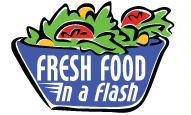
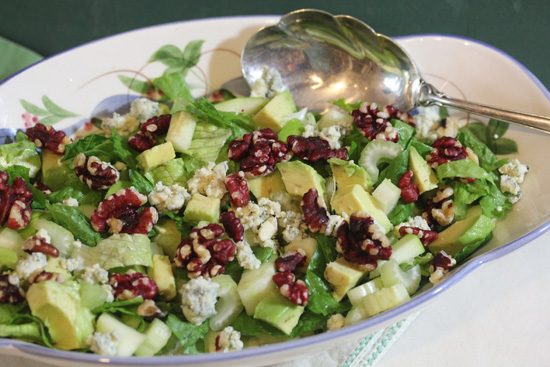

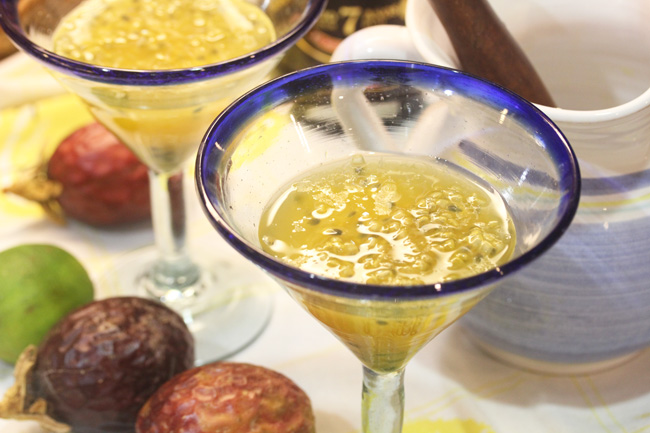
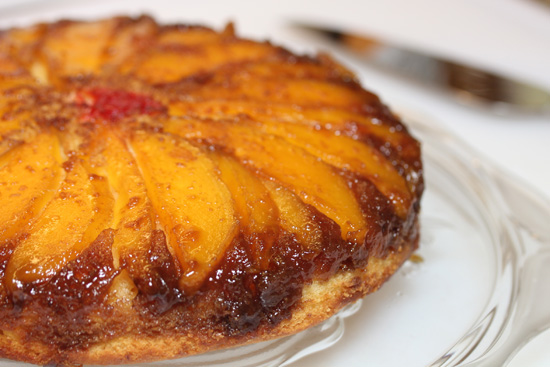
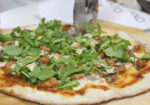
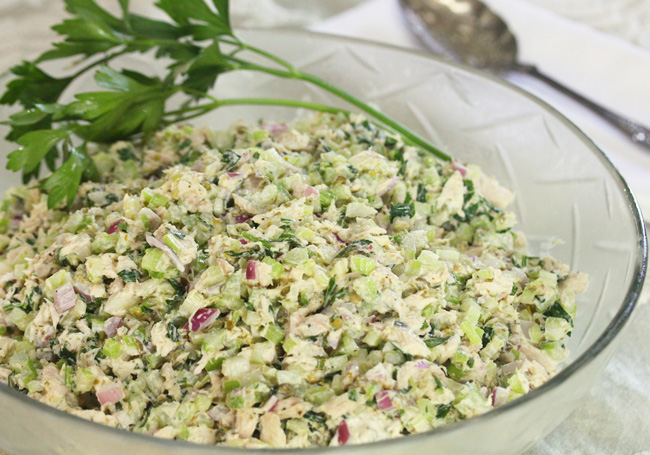
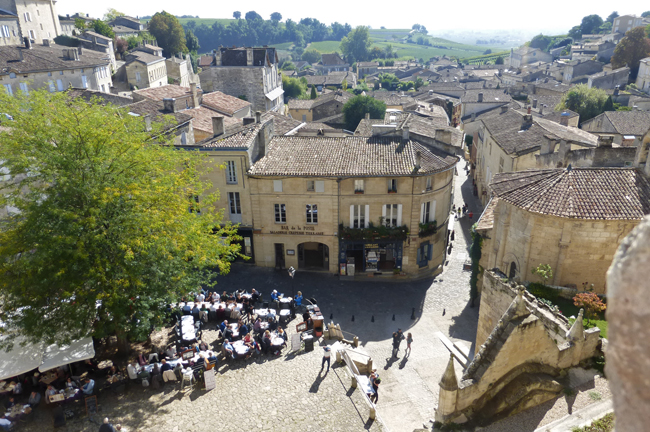
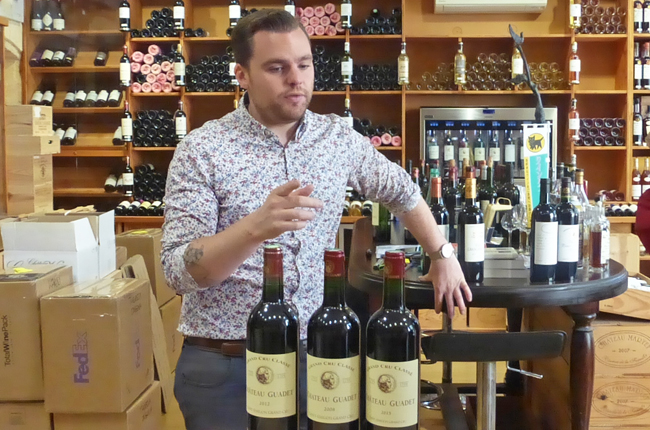
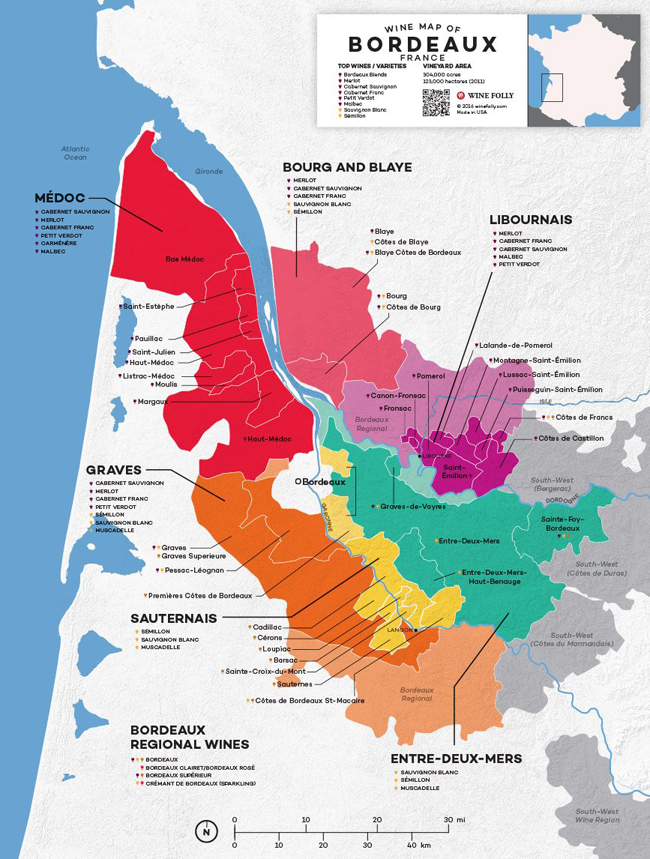
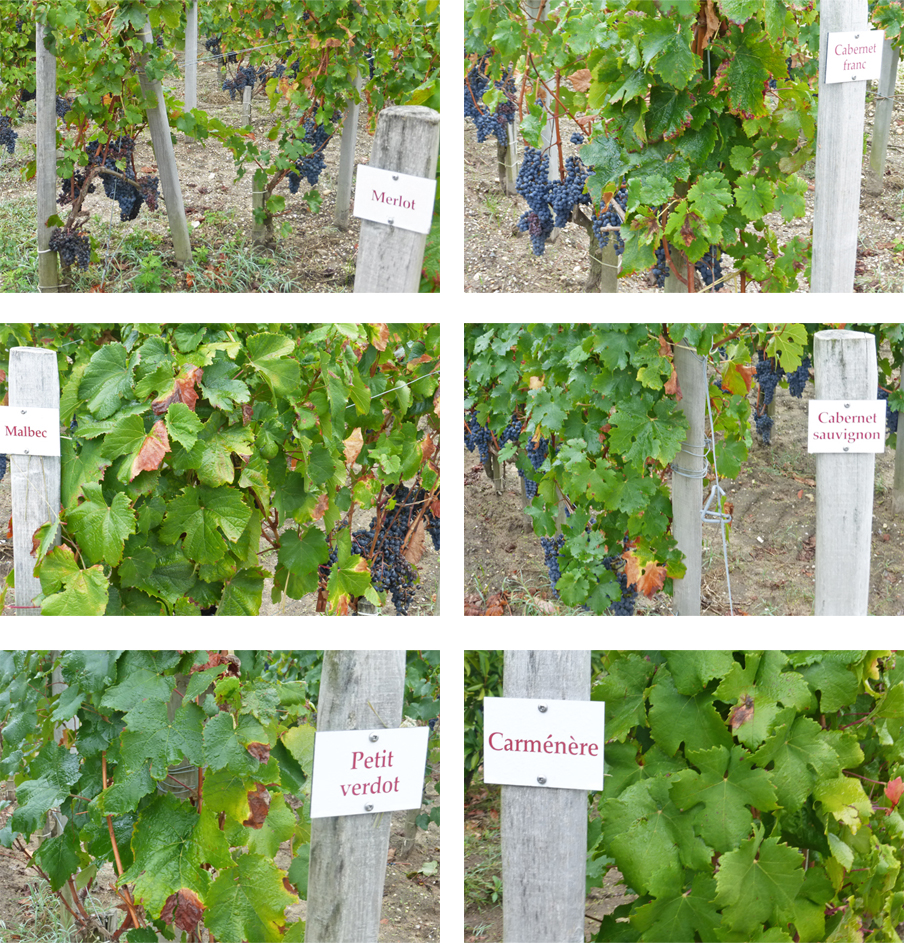
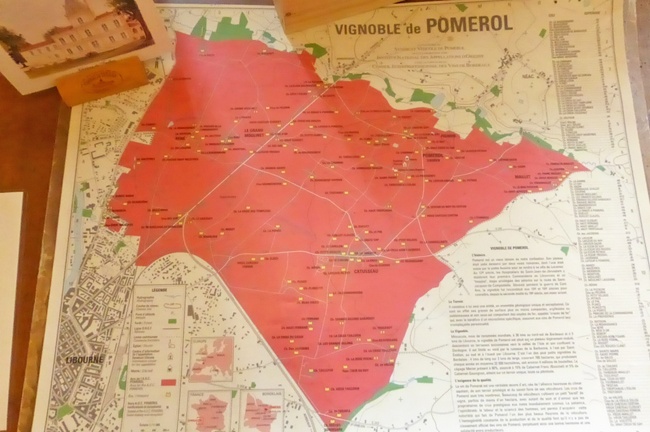
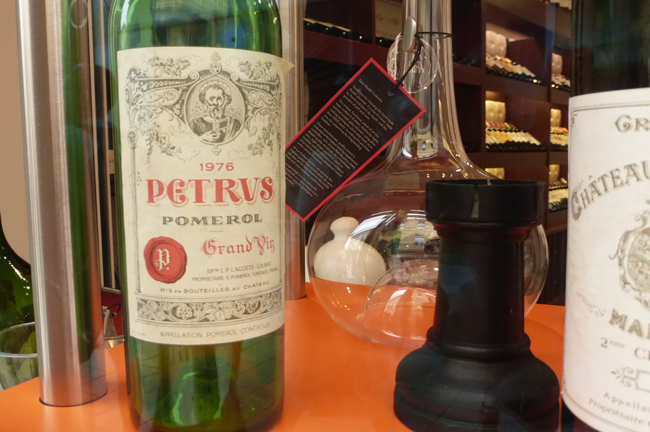
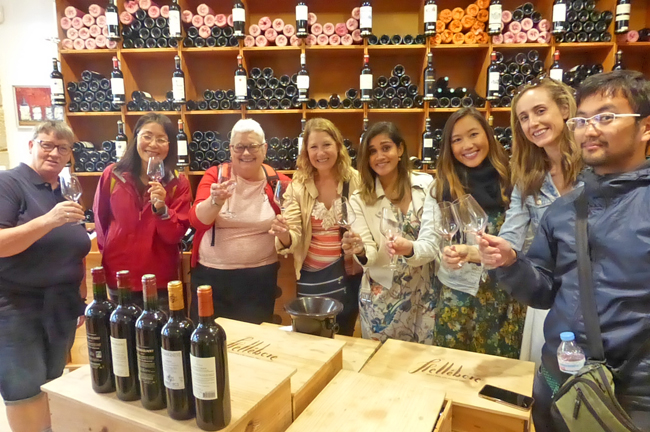
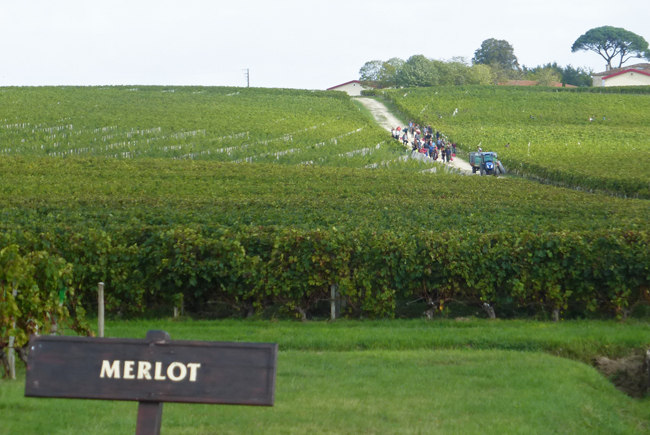
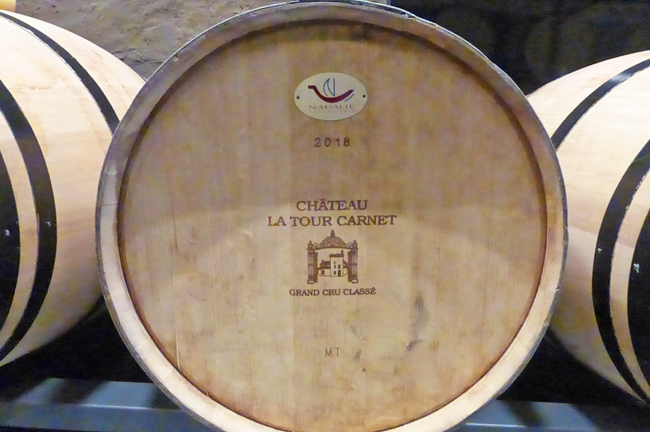
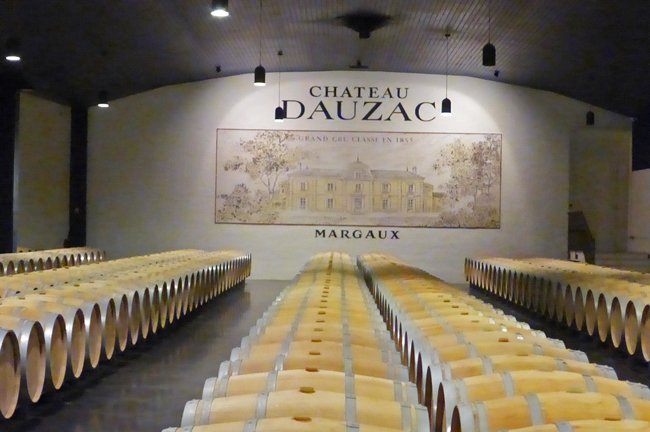
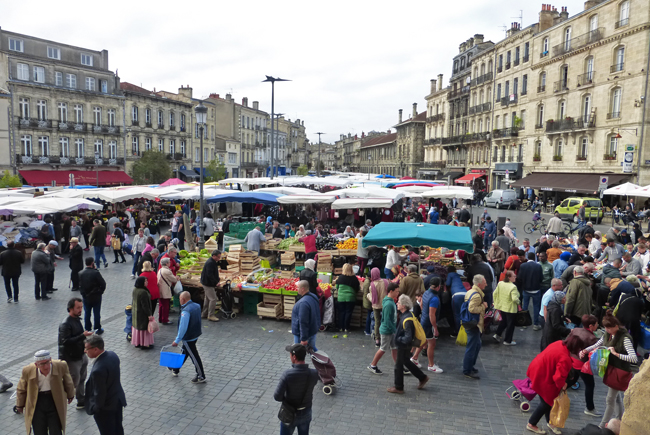
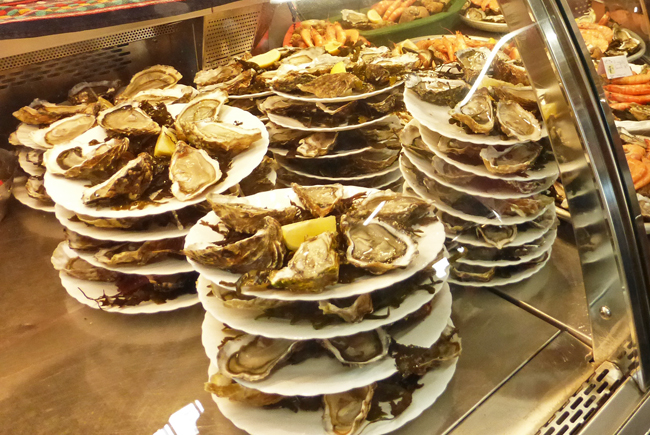
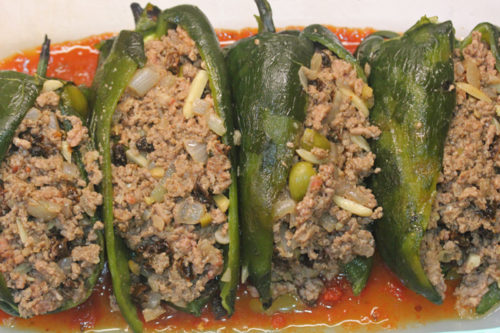

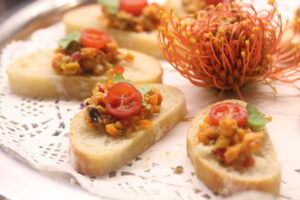
What a fabulous and comprehensive post on French wine. I toured the Bordeaux area and learned more from you. Thank you for this great information.
Cathy – What an honor to hear that you enjoyed my post and learned something about the Bordeaux wines.
Your post on French wines is informative and outstanding. Thank you.
Thank you Barbara. Coming from a well-versed food professional like you, I am humbled.
Thank you, Patricia. You always inform in an entertaining way. Pun intended, 🙂
Coming from an entertaining guy, a nice compliment. Thank you Mark.